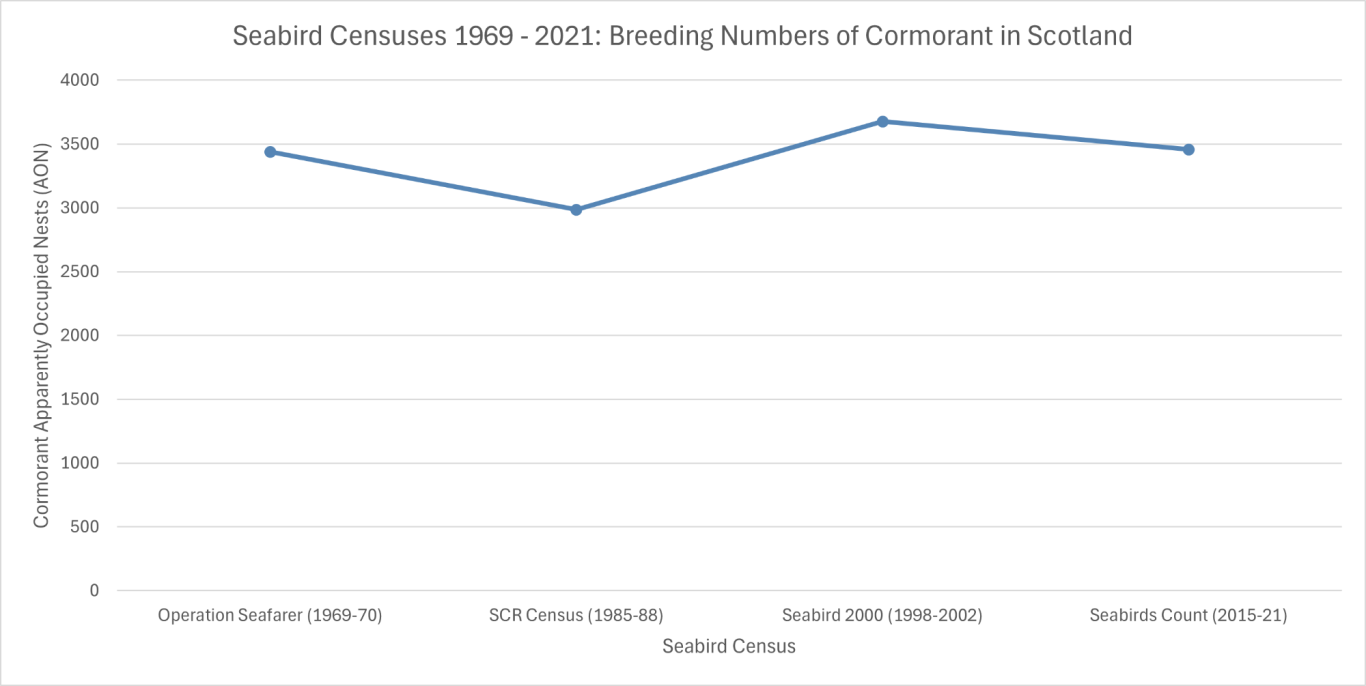www.stateofthecoast.scot
Great Cormorant (Phalacrocorax carbo)
Key Findings
Cormorant (Phalacrocorax carbo) are a large seabird with a long, thick neck. Adult breeding plumage consists of an all black body with a blue-ish tinge and wings with a bronze hue. They have a white and yellow 'chin', with a strong long beak hooked on the end (Fig. 1) (Svensson et al, 2020). They can often be seen standing on rocks with their wings spread wide, drying out.
Cormorants will nest inland and coastally, with coastal cormorants nesting on sea stacks, cliff ledges, or rocky headlands. Roosting birds can be found in areas such as sandbanks or rocky shores. Their diet largely consists of various fish such as salmon (Salmo salar) and sea trout (Salmo trutta trutta). Cormorants typically live up to 11 years old, breeding at 3 years (Svensson et al; Harris et al, 2024).
Population & Distribution:
At least 2% of the global cormorant breeding population is hosted by Britain and Ireland, alongside 3-4% of the global population of subspecies carbo and sinensis. Approximately 26% of the Britain and Ireland population can be found in Scotland (Fig. 2) (Burnell et al, 2023; Harris et al, 2024).
Cormorants are common on the east coast throughout the year, particularly throughout the winter but with numbers of breeding cormorants increasing in the region. Breeding has been recorded at various sites including Loch of Strathbeg, Rattray Head, Bullers of Buchan, Dunbuy Island (Cruden Bay), Newtonhill, Stonehaven, Fowlsheugh, and Inverbervie (Fig. 3). The species has been recorded at other locations along the coast including Cairnbulg, Peterhead, Ythan Estuary and Aberdeen Harbour where they will rest or roost (North East Scotland Bird Reports).
Conservation Status:
Cormorant are a Green listed species (Stanbury et al, 2024). During the latest seabird census Seabird Counts 2015-21 it was found that the cormorant population in Scotland had declined by 6% since the previous census Seabird 2000 in 1998-2002 (Burnell et al, 2023). Overall, the population in the UK is considered stable.
Factors Impacting Cormorants:
Cormorants have been classified as highly vulnerable to climate change, with their foraging habits sensitive to rising sea surface temperatures in combination with other factors such as fisheries, disturbance (at nest and roost sites) and pollutants (Burthe et al, 2014). Cormorants are vulnerable to being caught as fishery bycatch in gillnets, particularly in shallower waters and over the winter months (Northridge et al, 2023).
The fish preferences of cormorants such as salmon and sea trout can bring them into conflict with fisheries and anglers. As a result, NatureScot has the power grant licenses for lethal control of cormorants to reduce the numbers of fish taken at a local/site level. However, the impact this has on cormorants at a wider population level in Scotland is largely unknown (Humphreys et al, 2016).
Highly Pathogenic Avian Influenza (HPAI) has caused low mortality in cormorants as of November 2022 (Tremlett et al, 2024).
Report any sightings to BirdTrack, or NESBReC via the link below.

Figure 1: (JJ Harrison) Cormorant

Figure 2: Cormorant Counts in Scotland for each Seabird Census 1969 - 2021 (Mitchell et al, 2004; Burnell et al, 2023)

Figure 3: Cormorant Counts in Local Areas for each Seabird Census 1969 - 2021 (Mitchell et al, 2004; Burnell et al, 2023)
Notes
Linked Information Sheets
Key sources of Information
Mitchell et al (2004) Seabird Populations of Britain and Ireland
NESBReC (n.d.) North East Scotland Biological Records Centre
North East Scotland - Bird Report, latest issue 2022 published Feb 2024
Northridge et al (2023) Regional seabird bycatch hotspot analysis
Stanbury et al (2024) The status of the UK’s breeding seabirds
Reviewed on/by
Status
Live - Next review due 14/03/2026
To report errors, highlight new data, or discuss alternative interpretations, please complete the form below and we will aim to respond to you within 28 days
Contact us
Telephone: 07971149117
E-mail: ian.hay@stateofthecoast.scot
We need your consent to load the translations
We use a third-party service to translate the website content that may collect data about your activity. Please review the details in the privacy policy and accept the service to view the translations.

